dashboard warning lights FIAT PUNTO 2021 Owner handbook (in English)
[x] Cancel search | Manufacturer: FIAT, Model Year: 2021, Model line: PUNTO, Model: FIAT PUNTO 2021Pages: 219, PDF Size: 9.82 MB
Page 79 of 219
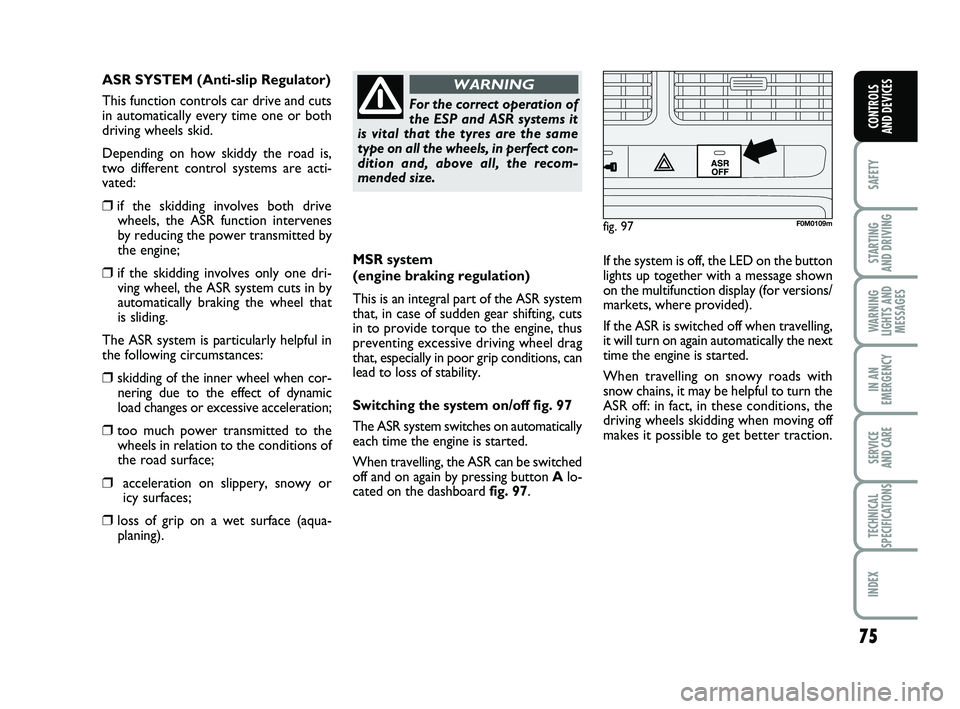
75
SAFETY
STARTING
AND DRIVING
WARNING
LIGHTS AND MESSAGES
IN AN
EMERGENCY
SERVICE
AND CARE
TECHNICAL
SPECIFICATIONS
INDEX
CONTROLS
AND DEVICES
MSR system
(engine braking regulation)
This is an integral part of the ASR system
that, in case of sudden gear shifting, cuts
in to provide torque to the engine, thus
preventing excessive driving wheel drag
that, especially in poor grip conditions, can
lead to loss of stability.
Switching the system on/off fig. 97
The ASR system switches on automatically
each time the engine is started.
When travelling, the ASR can be switched
off and on again by pressing button Alo-
cated on the dashboard fig. 97. If the system is off, the LED on the button
lights up together with a message shown
on the multifunction display (for versions/
markets, where provided).
If the ASR is switched off when travelling,
it will turn on again automatically the next
time the engine is started.
When travelling on snowy roads with
snow chains, it may be helpful to turn the
ASR off: in fact, in these conditions, the
driving wheels skidding when moving off
makes it possible to get better traction.
For the correct operation of
the ESP and ASR systems it
is vital that the tyres are the same
type on all the wheels, in perfect con-
dition and, above all, the recom-
mended size.
WARNING
fig. 97
ASR OFF
F0M0109m
ASR SYSTEM (Anti-slip Regulator)
This function controls car drive and cuts
in automatically every time one or both
driving wheels skid.
Depending on how skiddy the road is,
two different control systems are acti-
vated:
❒if the skidding involves both drivewheels, the ASR function intervenes
by reducing the power transmitted by
the engine;
❒if the skidding involves only one dri-ving wheel, the ASR system cuts in by
automatically braking the wheel that
is sliding.
The ASR system is particularly helpful in
the following circumstances:
❒skidding of the inner wheel when cor- nering due to the effect of dynamic
load changes or excessive acceleration;
❒too much power transmitted to thewheels in relation to the conditions of
the road surface;
❒acceleration on slippery, snowy oricy surfaces;
❒loss of grip on a wet surface (aqua- planing).
070-090 PUNTO POP 1ed EN 24/03/14 11:36 Pagina 75
Page 81 of 219

77
SAFETY
STARTING
AND DRIVING
WARNING
LIGHTS AND MESSAGES
IN AN
EMERGENCY
SERVICE
AND CARE
TECHNICAL
SPECIFICATIONS
INDEX
CONTROLS
AND DEVICES
“DUALDRIVE”
ELECTRIC
POWER
STEERING SYSTEM
The car is equipped with an electrically
controlled power steering system called
“Dualdrive”, working only with the igni-
tion key at MARand the engine running,
that customises steering force according
to the driving conditions.
ACTIVATION/DEACTIVATION
(CITY function)
To activate/deactivate the function, press
the button on the dashboard.
Activation is indicated by:
❒the word CITYon the instrument
panel (for versions with multifunction
display);
❒the word CITY lit up on the button
after it has been pressed fig. 98.When the CITY
function is on, the steer-
ing wheel effort is lighter, making parking
easier: therefore, this function is particu-
larly useful for driving in city centres.
For the Sport version, this function guar-
antees improved driving comfort because
the accelerator pedal is better calibrated
for gradual acceleration/deceleration.
fig. 98F0M0621m
070-090 PUNTO POP 1ed EN 24/03/14 11:36 Pagina 77
Page 84 of 219
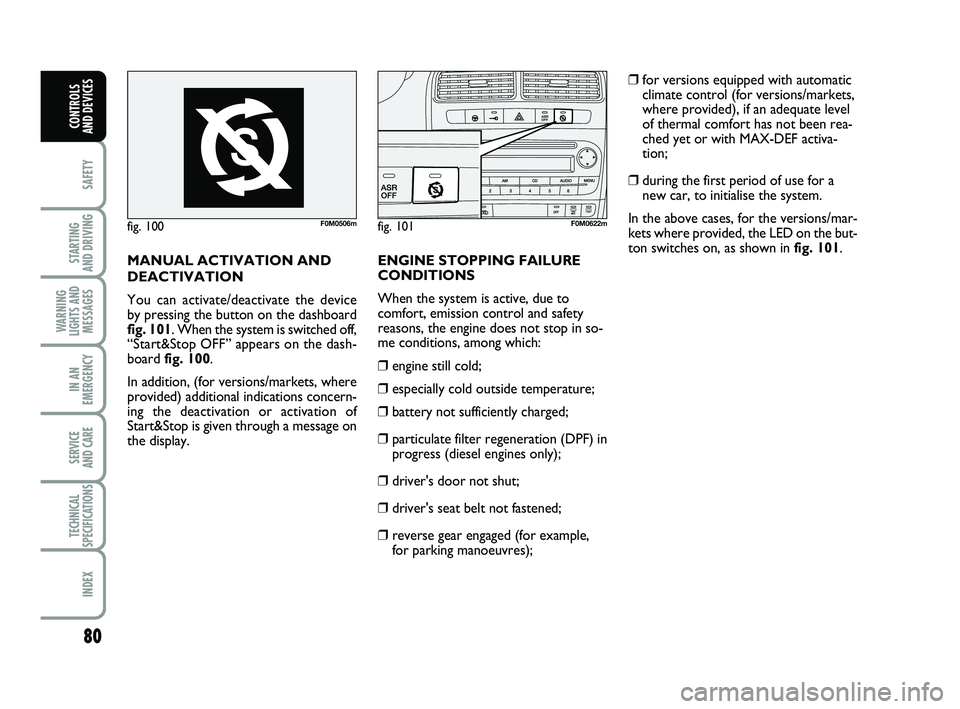
80
SAFETY
STARTING
AND DRIVING
WARNING
LIGHTS AND MESSAGES
IN AN
EMERGENCY
SERVICE
AND CARE
TECHNICAL
SPECIFICATIONS
INDEX
CONTROLS
AND DEVICES
fig. 100F0M0506mfig. 101F0M0622m
MANUAL ACTIVATION AND
DEACTIVATION
You can activate/deactivate the device
by pressing the button on the dashboard
fig. 101. When the system is switched off,
“Start&Stop OFF” appears on the dash-
board fig. 100.
In addition, (for versions/markets, where
provided) additional indications concern-
ing the deactivation or activation of
Start&Stop is given through a message on
the display. ENGINE STOPPING FAILURE
CONDITIONS
When the system is active, due to
comfort, emission control and safety
reasons, the engine does not stop in so-
me conditions, among which:
❒
engine still cold;
❒ especially cold outside temperature;
❒ battery not sufficiently charged;
❒ particulate filter regeneration (DPF) in
progress (diesel engines only);
❒ driver's door not shut;
❒ driver's seat belt not fastened;
❒ reverse gear engaged (for example,
for parking manoeuvres); ❒
for versions equipped with automatic
climate control (for versions/markets,
where provided), if an adequate level
of thermal comfort has not been rea-
ched yet or with MAX-DEF activa-
tion;
❒ during the first period of use for a
new car, to initialise the system.
In the above cases, for the versions/mar-
kets where provided, the LED on the but-
ton switches on, as shown in fig. 101.
070-090 PUNTO POP 1ed EN 24/03/14 11:36 Pagina 80
Page 102 of 219
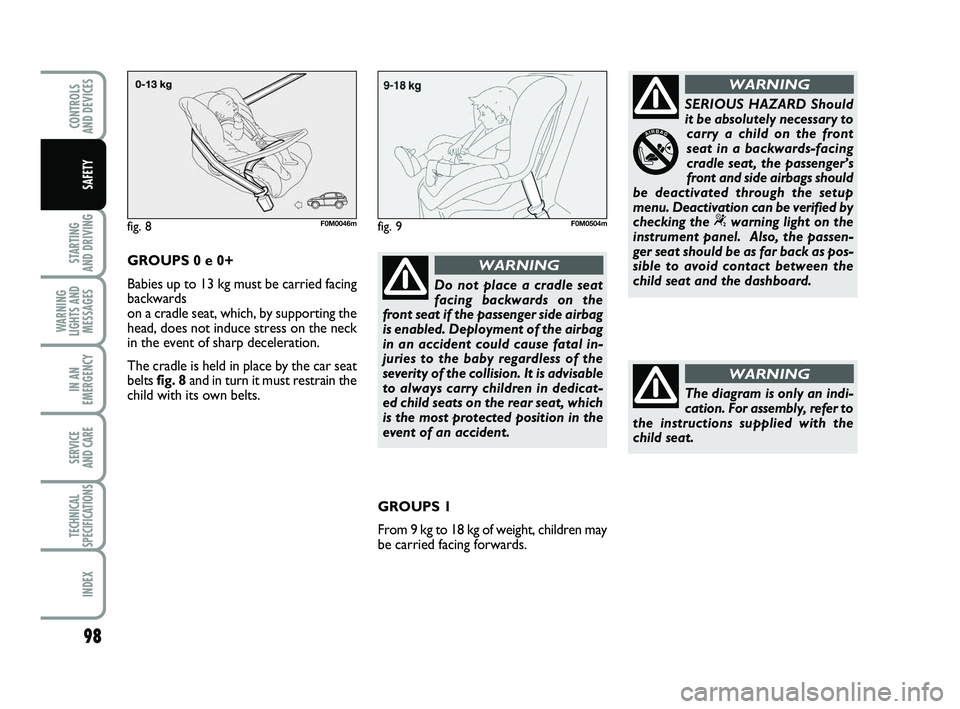
98
STARTING
AND DRIVING
WARNING
LIGHTS AND MESSAGES
IN AN
EMERGENCY
SERVICE
AND CARE
TECHNICAL
SPECIFICATIONS
INDEX
CONTROLS
AND DEVICES
SAFETY
Do not place a cradle seat
facing backwards on the
front seat if the passenger side airbag
is enabled. Deployment of the airbag
in an accident could cause fatal in-
juries to the baby regardless of the
severity of the collision. It is advisable
to always carry children in dedicat-
ed child seats on the rear seat, which
is the most protected position in the
event of an accident.
WARNING
SERIOUS HAZARD Should
it be absolutely necessary to carry a child on the front
seat in a backwards-facing
cradle seat, the passenger’s
front and side airbags should
be deactivated through the setup
menu. Deactivation can be verified by
checking the
“warning light on the
instrument panel. Also, the passen-
ger seat should be as far back as pos-
sible to avoid contact between the
child seat and the dashboard.
WARNING
fig. 8F0M0046mfig. 9F0M0504m
The diagram is only an indi-
cation. For assembly, refer to
the instructions supplied with the
child seat.
WARNING
GROUPS 0 e 0+
Babies up to 13 kg must be carried facing
backwards
on a cradle seat, which, by supporting the
head, does not induce stress on the neck
in the event of sharp deceleration.
The cradle is held in place by the car seat
belts fig. 8 and in turn it must restrain the
child with its own belts.
GROUPS 1
From 9 kg to 18 kg of weight, children may
be carried facing forwards.
091-110 PUNTO POP 1ed EN 27/03/14 12:02 Pagina 98
Page 107 of 219
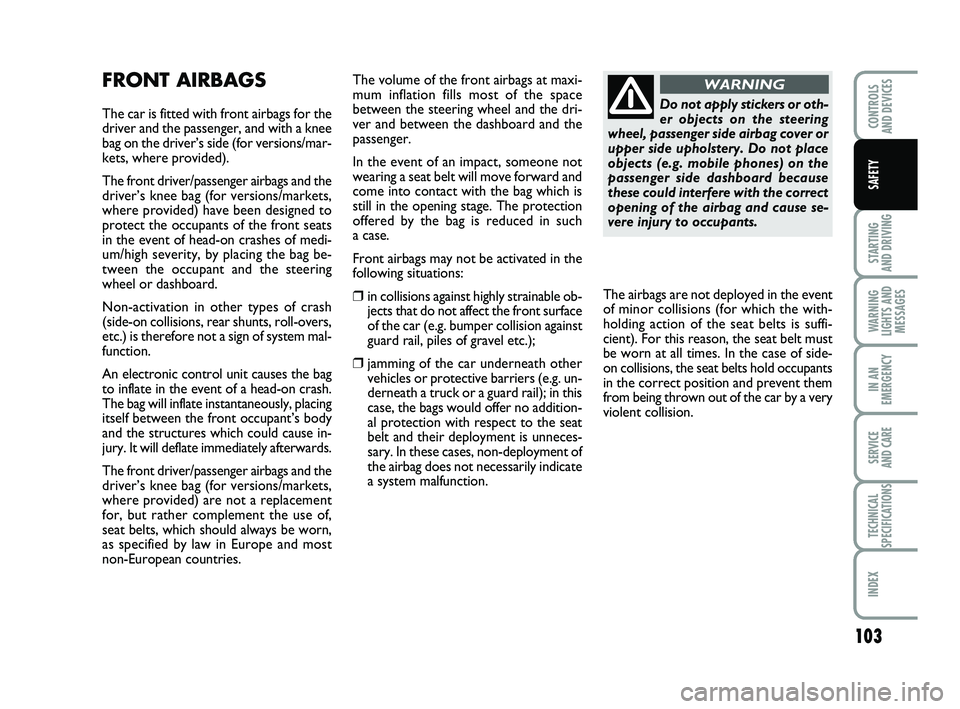
103
STARTING
AND DRIVING
WARNING
LIGHTS AND MESSAGES
IN AN
EMERGENCY
SERVICE
AND CARE
TECHNICAL
SPECIFICATIONS
INDEX
CONTROLS
AND DEVICES
SAFETY
FRONT AIRBAGS
The car is fitted with front airbags for the
driver and the passenger, and with a knee
bag on the driver’s side (for versions/mar -
kets, where provided).
The front driver/passenger airbags and the
driver’s knee bag (for versions/markets,
where provided) have been designed to
protect the occupants of the front seats
in the event of head-on crashes of medi-
um/high severity, by placing the bag be-
tween the occupant and the steering
wheel or dashboard.
Non-activation in other types of crash
(side-on collisions, rear shunts, roll-overs,
etc.) is therefore not a sign of system mal-
function.
An electronic control unit causes the bag
to inflate in the event of a head-on crash.
The bag will inflate instantaneously, placing
itself between the front occupant’s body
and the structures which could cause in-
jury. It will deflate immediately afterwards.
The front driver/passenger airbags and the
driver’s knee bag (for versions/markets,
where provided) are not a replacement
for, but rather complement the use of,
seat belts, which should always be worn,
as specified by law in Europe and most
non-European countries. The volume of the front airbags at maxi-
mum inflation fills most of the space
between the steering wheel and the dri-
ver and between the dashboard and the
passenger.
In the event of an impact, someone not
wearing a seat belt will move forward and
come into contact with the bag which is
still in the opening stage. The protection
offered by the bag is reduced in such
a case.
Front airbags may not be activated in the
following situations:
❒in collisions against highly strainable ob-
jects that do not affect the front surface
of the car (e.g. bumper collision against
guard rail, piles of gravel etc.);
❒jamming of the car underneath othervehicles or protective barriers (e.g. un-
derneath a truck or a guard rail); in this
case, the bags would offer no addition-
al protection with respect to the seat
belt and their deployment is unneces-
sary. In these cases, non-deployment of
the airbag does not necessarily indicate
a system malfunction.
Do not apply stickers or oth-
er objects on the steering
wheel, passenger side airbag cover or
upper side upholstery. Do not place
objects (e.g. mobile phones) on the
passenger side dashboard because
these could interfere with the correct
opening of the airbag and cause se-
vere injury to occupants.
WARNING
The airbags are not deployed in the event
of minor collisions (for which the with-
holding action of the seat belts is suffi-
cient). For this reason, the seat belt must
be worn at all times. In the case of side-
on collisions, the seat belts hold occupants
in the correct position and prevent them
from being thrown out of the car by a very
violent collision.
091-110 PUNTO POP 1ed EN 27/03/14 12:02 Pagina 103
Page 108 of 219
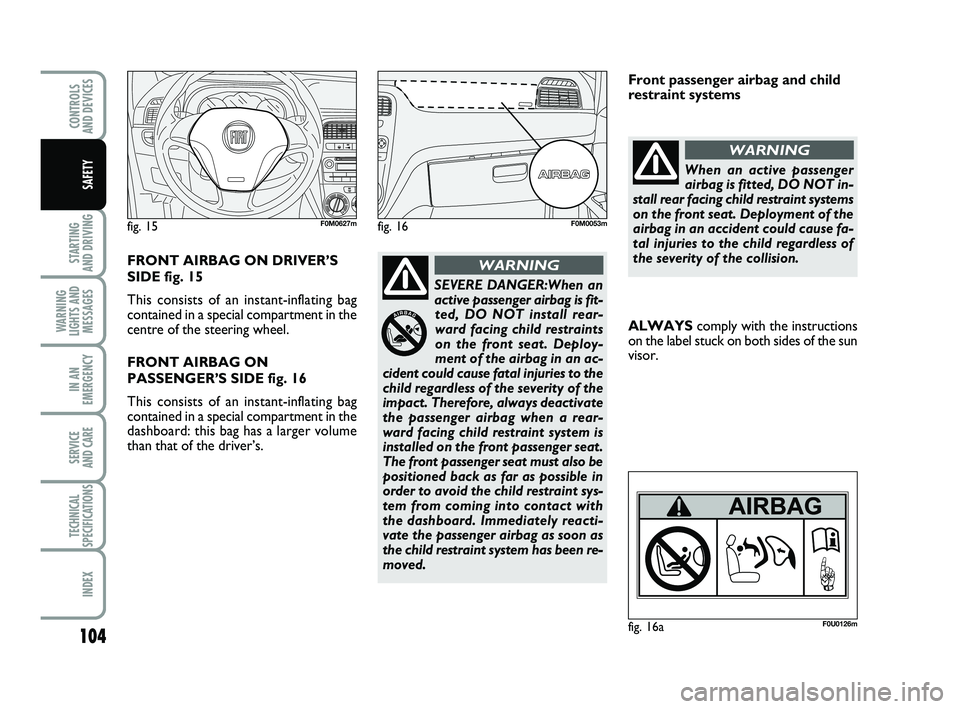
104
STARTING
AND DRIVING
WARNING
LIGHTS AND MESSAGES
IN AN
EMERGENCY
SERVICE
AND CARE
TECHNICAL
SPECIFICATIONS
INDEX
CONTROLS
AND DEVICES
SAFETY
SEVERE DANGER:When an
active passenger airbag is fit- ted, DO NOT install rear-
ward facing child restraints
on the front seat. Deploy-
ment of the airbag in an ac-
cident could cause fatal injuries to the
child regardless of the severity of the
impact. Therefore, always deactivate
the passenger airbag when a rear-
ward facing child restraint system is
installed on the front passenger seat.
The front passenger seat must also be
positioned back as far as possible in
order to avoid the child restraint sys-
tem from coming into contact with
the dashboard. Immediately reacti-
vate the passenger airbag as soon as
the child restraint system has been re-
moved.
WARNING
fig. 15F0M0627mfig. 16F0M0053m
FRONT AIRBAG ON DRIVER’S
SIDE fig. 15
This consists of an instant-inflating bag
contained in a special compartment in the
centre of the steering wheel.
FRONT AIRBAG ON
PASSENGER’S SIDE fig. 16
This consists of an instant-inflating bag
contained in a special compartment in the
dashboard: this bag has a larger volume
than that of the driver’s. ALWAYS
comply with the instructions
on the label stuck on both sides of the sun
visor. Front passenger airbag and child
restraint systems
When an active passenger
airbag is fitted, DO NOT in-
stall rear facing child restraint systems
on the front seat. Deployment of the
airbag in an accident could cause fa-
tal injuries to the child regardless of
the severity of the collision.
WARNING
fig. 16aF0U0126m
091-110 PUNTO POP 1ed EN 03/04/14 14:54 Pagina 104
Page 110 of 219
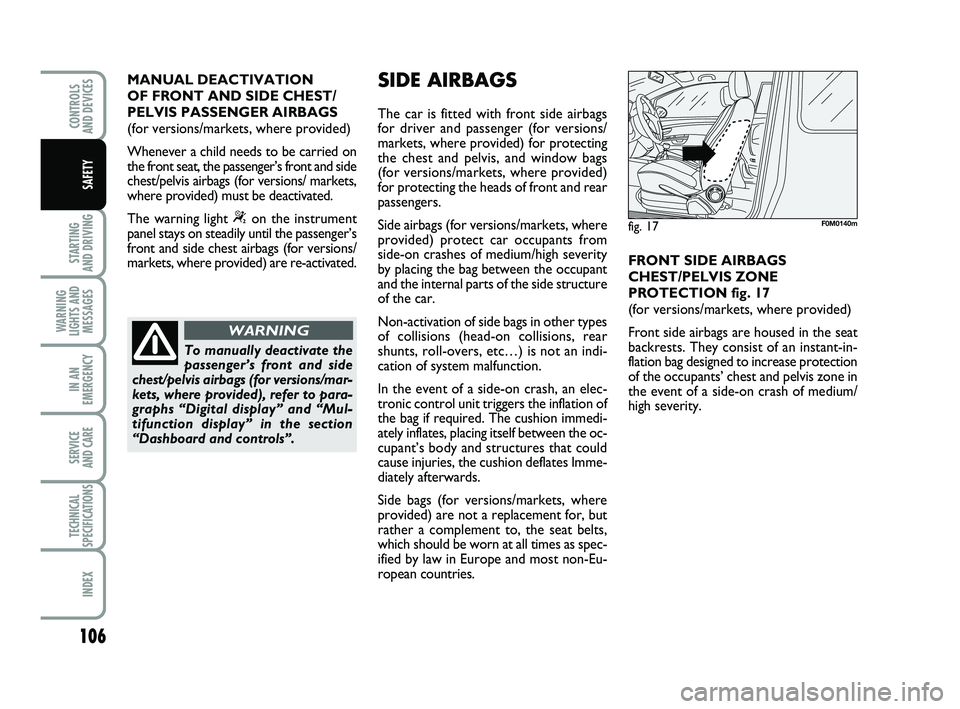
106
STARTING
AND DRIVING
WARNING
LIGHTS AND MESSAGES
IN AN
EMERGENCY
SERVICE
AND CARE
TECHNICAL
SPECIFICATIONS
INDEX
CONTROLS
AND DEVICES
SAFETY
MANUAL DEACTIVATION
OF FRONT AND SIDE CHEST/
PELVIS PASSENGER AIRBAGS
(for versions/markets, where provided)
Whenever a child needs to be carried on
the front seat, the passenger’s front and side
chest/pelvis airbags (for versions/ markets,
where provided) must be deactivated.
The warning light
“on the instrument
panel stays on steadily until the passenger’s
front and side chest airbags (for versions/
markets, where provided) are re-activated.
To manually deactivate the
passenger’s front and side
chest/pelvis airbags (for versions/mar -
kets, where provided), refer to para-
graphs “Digital display” and “Mul -
tifunction display” in the section
“Dashboard and controls”.
WARNING
SIDE AIRBAGS
The car is fitted with front side airbags
for driver and passenger (for versions/
mar kets, where provided) for protecting
the chest and pelvis, and window bags
(for versions/markets, where provided)
for protecting the heads of front and rear
passengers.
Side airbags (for versions/markets, where
provided) protect car occupants from
side-on crashes of medium/high severity
by placing the bag between the occupant
and the internal parts of the side structure
of the car.
Non-activation of side bags in other types
of collisions (head-on collisions, rear
shunts, roll-overs, etc…) is not an indi-
cation of system malfunction.
In the event of a side-on crash, an elec-
tronic control unit triggers the inflation of
the bag if required. The cushion immedi-
ately inflates, placing itself between the oc-
cupant’s body and structures that could
cause injuries, the cushion deflates Imme-
diately afterwards.
Side bags (for versions/markets, where
provided) are not a replacement for, but
rather a complement to, the seat belts,
which should be worn at all times as spec-
ified by law in Europe and most non-Eu-
ropean countries. FRONT SIDE AIRBAGS
CHEST/PELVIS ZONE
PROTECTION fig. 17
(for versions/markets, where provided)
Front side airbags are housed in the seat
backrests. They consist of an instant-in-
flation bag designed to increase protection
of the occupants’ chest and pelvis zone in
the event of a side-on crash of medium/
high severity.
fig. 17F0M0140m
091-110 PUNTO POP 1ed EN 27/03/14 12:02 Pagina 106
Page 113 of 219
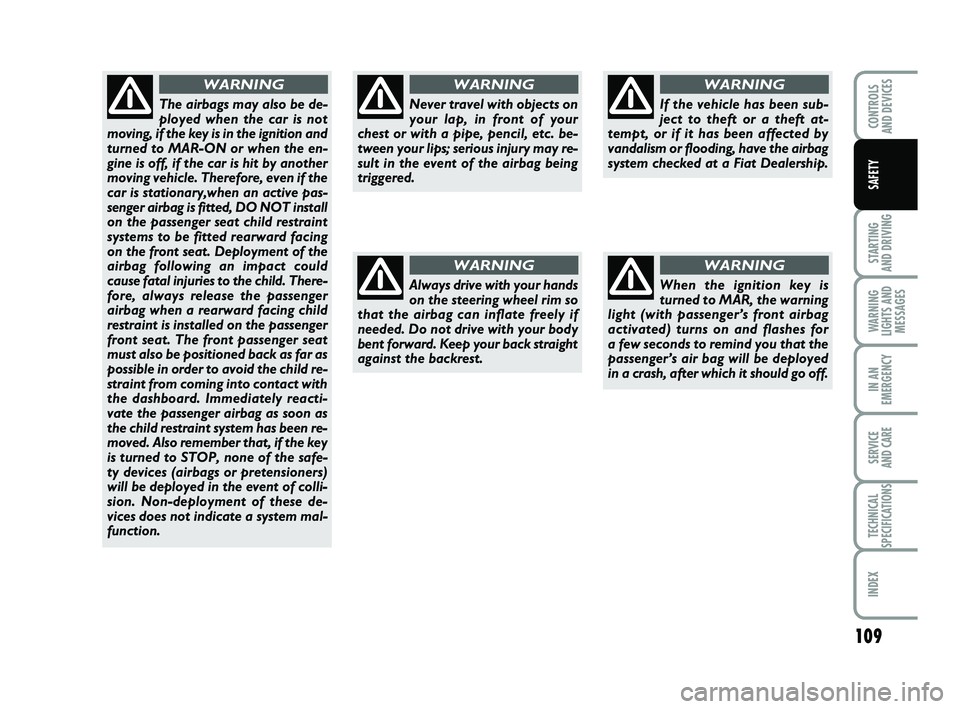
109
STARTING
AND DRIVING
WARNING
LIGHTS AND MESSAGES
IN AN
EMERGENCY
SERVICE
AND CARE
TECHNICAL
SPECIFICATIONS
INDEX
CONTROLS
AND DEVICES
SAFETY
Never travel with objects on
your lap, in front of your
chest or with a pipe, pencil, etc. be-
tween your lips; serious injury may re-
sult in the event of the airbag being
triggered.
WARNING
The airbags may also be de-
ployed when the car is not
moving, if the key is in the ignition and
turned to MAR-ON or when the en-
gine is off, if the car is hit by another
moving vehicle. Therefore, even if the
car is stationary,when an active pas-
senger airbag is fitted, DO NOT install
on the passenger seat child restraint
systems to be fitted rearward facing
on the front seat. Deployment of the
airbag following an impact could
cause fatal injuries to the child. There-
fore, always release the passenger
airbag when a rearward facing child
restraint is installed on the passenger
front seat. The front passenger seat
must also be positioned back as far as
possible in order to avoid the child re-
straint from coming into contact with
the dashboard. Immediately reacti-
vate the passenger airbag as soon as
the child restraint system has been re-
moved. Also remember that, if the key
is turned to STOP, none of the safe-
ty devices (airbags or pretensioners)
will be deployed in the event of colli-
sion. Non-deployment of these de-
vices does not indicate a system mal-
function.
WARNING
Always drive with your hands
on the steering wheel rim so
that the airbag can inflate freely if
needed. Do not drive with your body
bent forward. Keep your back straight
against the backrest.
WARNING
If the vehicle has been sub-
ject to theft or a theft at-
tempt, or if it has been affected by
vandalism or flooding, have the airbag
system checked at a Fiat Dealership.
WARNING
When the ignition key is
turned to MAR, the warning
light (with passenger’s front airbag
activated) turns on and flashes for
a few seconds to remind you that the
passenger’s air bag will be deployed
in a crash, after which it should go off.
WARNING
091-110 PUNTO POP 1ed EN 27/03/14 12:02 Pagina 109
Page 116 of 219
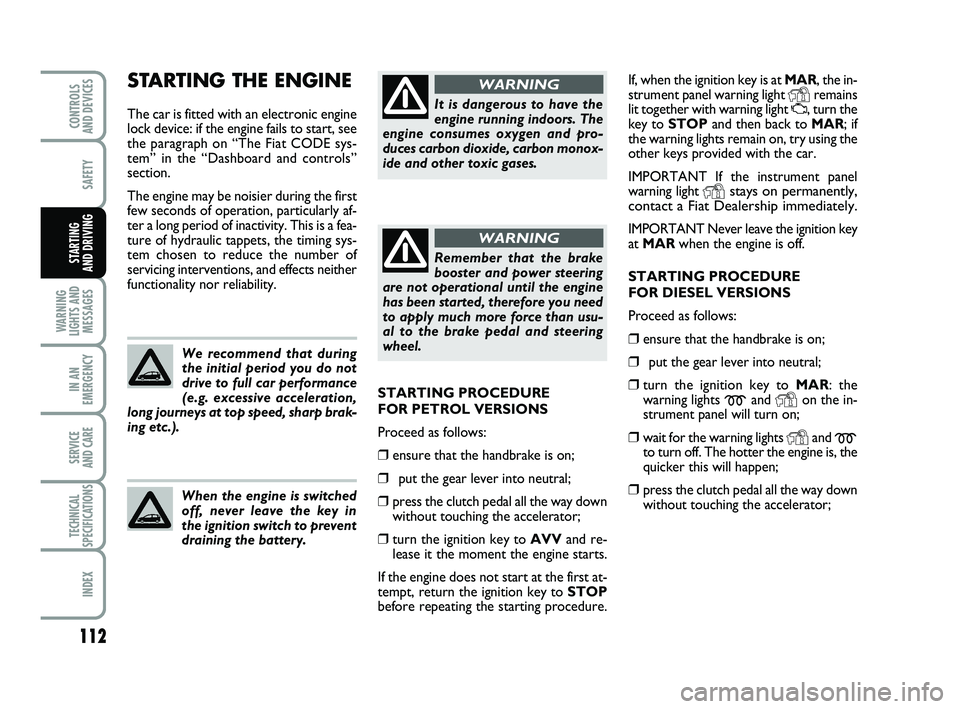
112
SAFETY
WARNING
LIGHTS AND MESSAGES
IN AN
EMERGENCY
SERVICE
AND CARE
TECHNICAL
SPECIFICATIONS
INDEX
CONTROLS
AND DEVICES
STARTING
AND DRIVING
If, when the ignition key is at MAR, the in-
strument panel warning light
Yremains
lit together with warning light U, turn the
key to STOP and then back to MAR; if
the warning lights remain on, try using the
other keys provided with the car.
IMPORTANT If the instrument panel
warning light
Ystays on permanently,
contact a Fiat Dealership immediately.
IMPORTANT Never leave the ignition key
at MAR when the engine is off.
STARTING PROCEDURE
FOR DIESEL VERSIONS
Proceed as follows:
❒ensure that the handbrake is on;
❒put the gear lever into neutral;
❒turn the ignition key to MAR: the
warning lights
mand Yon the in-
strument panel will turn on;
❒wait for the warning lights Yand mto turn off. The hotter the engine is, the
quicker this will happen;
❒press the clutch pedal all the way down without touching the accelerator;
STARTING THE ENGINE
The car is fitted with an electronic engine
lock device: if the engine fails to start, see
the paragraph on “The Fiat CODE sys-
tem” in the “Dashboard and controls”
section.
The engine may be noisier during the first
few seconds of operation, particularly af-
ter a long period of inactivity. This is a fea-
ture of hydraulic tappets, the timing sys-
tem chosen to reduce the number of
servicing interventions, and effects neither
functionality nor reliability.
We recommend that during
the initial period you do not
drive to full car performance
(e.g. excessive acceleration,
long journeys at top speed, sharp brak-
ing etc.).
When the engine is switched
off, never leave the key in
the ignition switch to prevent
draining the battery.
It is dangerous to have the
engine running indoors. The
engine consumes oxygen and pro-
duces carbon dioxide, carbon monox-
ide and other toxic gases.
WARNING
Remember that the brake
booster and power steering
are not operational until the engine
has been started, therefore you need
to apply much more force than usu-
al to the brake pedal and steering
wheel.
WARNING
STARTING PROCEDURE
FOR PETROL VERSIONS
Proceed as follows:
❒ensure that the handbrake is on;
❒put the gear lever into neutral;
❒press the clutch pedal all the way down without touching the accelerator;
❒turn the ignition key to AVVand re-
lease it the moment the engine starts.
If the engine does not start at the first at-
tempt, return the ignition key to STOP
before repeating the starting procedure.
111-120 PUNTO POP 1ed EN 24/09/13 14.29 Pagina 112
Page 130 of 219
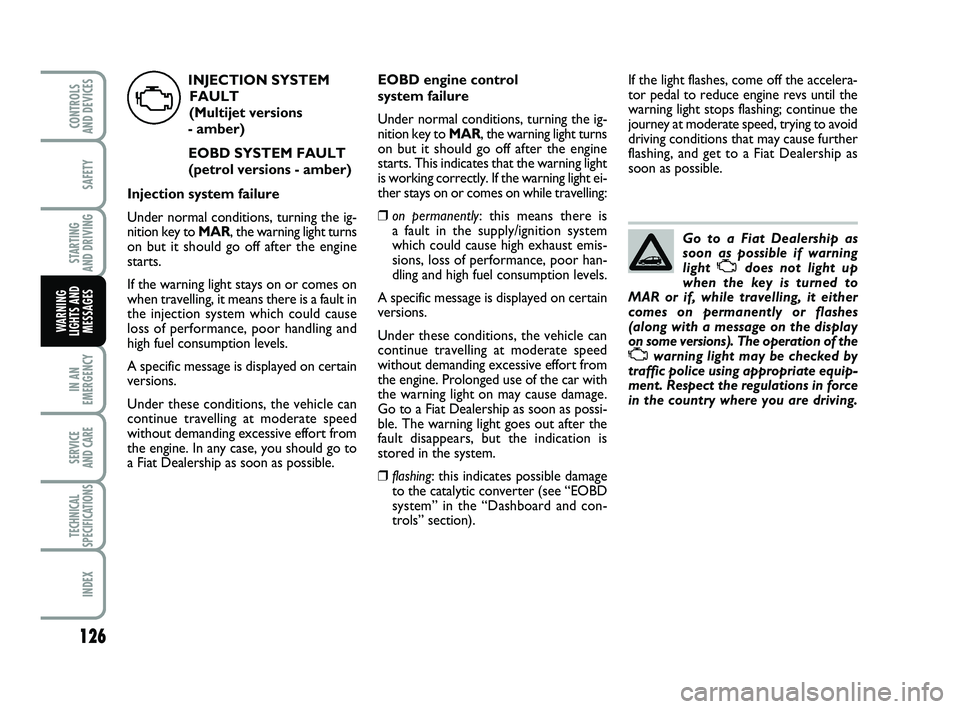
126
SAFETY
STARTING
AND DRIVING
IN AN
EMERGENCY
SERVICE
AND CARE
TECHNICAL
SPECIFICATIONS
INDEX
CONTROLS
AND DEVICES
WARNING
LIGHTS AND MESSAGES
Go to a Fiat Dealership as
soon as possible if warning
light
Udoes not light up
when the key is turned to
MAR or if, while travelling, it either
comes on permanently or flashes
(along with a message on the display
on some versions). The operation of the
Uwarning light may be checked by
traffic police using appropriate equip-
ment. Respect the regulations in force
in the country where you are driving.
If the light flashes, come off the accelera-
tor pedal to reduce engine revs until the
warning light stops flashing; continue the
journey at moderate speed, trying to avoid
driving conditions that may cause further
flashing, and get to a Fiat Dealership as
soon as possible.
EOBD engine control
system failure
Under normal conditions, turning the ig-
nition key to MAR, the warning light turns
on but it should go off after the engine
starts. This indicates that the warning light
is working correctly. If the warning light ei-
ther stays on or comes on while travelling:
❒
on permanently: this means there is
a fault in the supply/ignition system
which could cause high exhaust emis-
sions, loss of performance, poor han-
dling and high fuel consumption levels.
A specific message is displayed on certain
versions.
Under these conditions, the vehicle can
continue travelling at moderate speed
without demanding excessive effort from
the engine. Prolonged use of the car with
the warning light on may cause damage.
Go to a Fiat Dealership as soon as possi-
ble. The warning light goes out after the
fault disappears, but the indication is
stored in the system.
❒ flashing: this indicates possible damage
to the catalytic converter (see “EOBD
system” in the “Dashboard and con-
trols” section).
INJECTION SYSTEM
FAULT
(Multijet versions
- amber)
EOBD SYSTEM FAULT
(petrol versions - amber)
Injection system failure
Under normal conditions, turning the ig-
nition key to MAR, the warning light turns
on but it should go off after the engine
starts.
If the warning light stays on or comes on
when travelling, it means there is a fault in
the injection system which could cause
loss of performance, poor handling and
high fuel consumption levels.
A specific message is displayed on certain
versions.
Under these conditions, the vehicle can
continue travelling at moderate speed
without demanding excessive effort from
the engine. In any case, you should go to
a Fiat Dealership as soon as possible.
U
121-132 PUNTO POP 1ed EN 29/08/13 15.03 Pagina 126